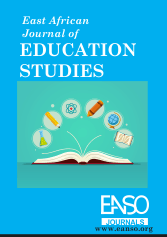Class size and Learners’ Engagement in Physics Practicals in Ordinary Level Secondary Schools of Bukanga North County, Isingiro District
Abstract
The study investigated the effect of class size on learners’ engagement in physics practicals in ordinary-level secondary schools in Bukanga North County, Isingiro District. The objective of the study was to examine the effect of the number of students on learners’ interaction with teachers during physics practicals. The study used a correlational survey design. The study population included senior three learners, physics teachers, laboratory attendants, school headteachers, the District Education Officer, and the District Inspector of Schools. A sample size of 352 respondents was used. Sampling methods included purposive and random techniques. The data collection methods included self-administered questionnaires, interview guides, and observation checklists. Qualitative data was analysed using thematic, content, and narrative analysis while quantitative data was analysed with SPSS. A significant positive correlation (r = 0.820) suggested that as the number of students decreased, the learners’ interaction with the teacher in ordinary-level physics practicals increased. The research recommends that schools should reduce student numbers in physics practical classes, provide teacher training, implement flexible seating arrangements, ensure proper classroom resources, determine an optimal number of students, and consider classroom layout adjustments to enhance the effectiveness of physics practicals
Downloads
References
Adewale, et al. (2019). Impact of student-teacher ratio on learners' engagement in Nigerian public secondary schools. Journal of Education and Development Studies, 24(3).
Brown, A., & Williams, C. (2022). Teacher-student ratio and its implications for learners' engagement in Uganda secondary schools. Educational Development, 45, 78-92.
Brown, A., Smith, B., & Williams, C. (2019). The impact of teacher-student ratio on learners' engagement in Ugandan secondary schools. Journal of Education Research, 35(2).
Capanis N., (2010). How Pre-Service Teachers’ Understand and Perform Science Process Skills. Eurasia Journal of Mathematics, Science and Technology Education, 7(2), 106-214.
Daily Monitor. (2021, February 16). Student Performance and Behavior in Uganda.
Garwin, M.R., & Ramsier, R.D. (2013). Experiential learning at the university level: a US case study. Education and Training, 45(5), 280-285.
Gekelman W. (2011). Using plasma experiments to illustrate a complex index of refraction. American Journal of Physics, 79(9), 894-902.
Toplis, et al. (2016). Student engagement in the language classroom. Bristol, UK: Multilingual Matters.
Inspector of Schools Report (2019). Report on Paving Teachers for What They Know and Do: A Review of Policies, Strategies, and Practices, Isingiro District.
Johnson, et al. (2022). The Effect of Number of Students on Ordinary Level Learners' Engagement in South Africa. South African Journal of Education, 25(3), 112-127.
Johnson, D. (2021). Exploring the Relationship Between Teacher-Student Ratio and Learners' Engagement: A Case Study of Secondary Schools in Uganda. Educational Studies Quarterly, 48(4), 567-589.
Johnson, et al. (2019). Student-to-Teacher Ratio and Learners' Engagement: A Longitudinal Study in Sweden. International Journal of Educational Studies, 72(3), 301-316.
Ministry of Education and Sports, MoES (2018). Uganda Educational Statistics Abstract: Secondary School Annual Classroom Inspection.
Ouko and Mwinzi (2017). The Effect of Number of Students on Ordinary Level Learners' Engagement in Kenya. Journal of Educational Research and Practice, 25(4), 367-382.
Kagendo & Kamau (2019). Students' Classroom Engagement Produces Longitudinal Changes in Classroom Motivation. Journal of Educational Psychology, 106(2), 527–540.
Goodlad, Soder, & Sirotnik (2014). The Effect of Student Ratio on Learners' Engagement: A Mixed-Method. Journal of Education Research, 45(2), 167-184.
Smith, J. K. (2017). The Impact of Teacher-Student Ratio on Learners' Engagement: A Case Study of Isingiro Secondary Schools. Educational Studies Journal, 28(3), 45-58.
Uganda National Examinations Board (UNEB, 2021). Meeting Diversity in Education.
UNEB (2019). Students' Results and Performance Among Secondary and Secondary School Students, Kampala, Uganda.
Williams, S. M. (2021). Teacher-Student Ratio and Its Influence on Learners' Engagement in Isingiro Secondary Schools: A Qualitative Study. Journal of Educational Psychology, 10(4), 67-80.
Copyright (c) 2024 Frank Kamugisha, Irene Aheisibwe, PhD, Donah Asimiire, PhD

This work is licensed under a Creative Commons Attribution 4.0 International License.




























